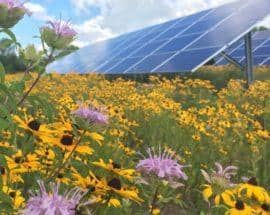
It hasn’t been easy sailing. RECs looking to go solar have to disentangle themselves from existing contracts, in addition to bucking political headwaters.
Nevertheless, the barriers are beginning to crumble even in Wisconsin, a state that has been an epicenter of Koch-funded anti-renewable activity.
More Solar Power For Wisconsin
Wisconsin rates a lowly 41 for installed solar capacity, which is even worse when you consider that 41 is a step down from last year, when the state weighed in at number 38 for PV installations.
That’s why the latest news is so exciting. Earlier this week Wisconsin’s Dairyland Power Cooperative laid claim to the entire 149 in solar capacity anticipated from a proposed new PV array in Jefferson County.
The project, called Badger State Solar, is under the umbrella of the PV developer Ranger Power.
The capacity figure of 149 megawatts translates into enough electricity to power more than 20,000 homes annually, which just about doubles the current statewide milestone of 10,331 homes in one fell swoop.
Do follow the link and support your friendly neighborhood journalist for more details about the new PV project, and on the ambitious renewable energy plans of newly minted Wisconsin Governor Tony Evers.
Gosh, maybe elections do have consequences. Whatever. The gist of it is that Evers proposed a net-zero power generation for all utilities operating in the state by 2050. That’s quite a turnaround for a state that still beats the national average for coal power generation by a wide margin.
Other major utilities in the state, including Xcel Energy, are already on board with the plan.
Dairyland Hearts Solar Power, But Baby Steps
If all goes according to plan, the new Badger State project will represent a decent chunk of Dairyland’s power generation. The current total is 1,350 megawatts, which includes only 25 megawatts in existing solar capacity.
Don’t break out the bubbly just yet, though. First of all, the Badger project is still in the proposal stage.
More to the point, Dairyland’s service territory includes a large swath of Wisconsin. It also spills over into Minnesota and two other states. According to a report in the Lacrosse Tribune, Dairyland is still wedded to the idea that a proposed joint venture for a new 550 megawatt natural gas plant with Minnesota Power is a good idea. In addition, its 2027 goal still includes 70% in natural gas and coal capacity.
Phooey!
RECs & The Green New Deal
Putting that little thing about natural gas aside, the Badger State project has all the markings of the Green New Deal. Here’s Barbara Nick, Dairyland President and CEOB enthusing over the new PV project with props for the environmental angle:
Resource diversification is foundational to Dairyland’s commitment to a sustainable, future-facing power supply. We look forward to Badger State Solar’s benefit to our cooperative membership, local communities and the environment.
Dairyland also points out that the project “is expected to bring significant economic impacts to the area,” including hundreds of construction jobs.
The project will support only five permanent jobs, but Ranger Power points to other benefits that support the agricultural community. Here’s the rundown from Ranger:
The site will feature grass and seed mixes below panels and within the site that will help build soil nutrients and reduce fertilizer, herbicide and pesticide use.
The facility will create pollinator habitat as well as possible opportunities for grazing.
Reduced stormwater runoff and soil erosion from the land hosting solar panels can improve downstream water quality.
That’s in addition to that thing about improving community health by cutting down on greenhouse gases and other pollutants.
For the record, Dairyland is under the umbrella of the Touchstone Energy Cooperative. Touchstone’s network includes 750 local RECs in 46 states, making it the largest utility in the US.
Yes, really.
Touchstone has a pretty nifty way of summarizing the intention behind the co-op system, so we’re including it in full:
Electric cooperative members share more than electricity. They share the same principles. That’s because electric co-ops are located in the communities they power and work hard to improve quality of life for all.
Additionally, electric co-ops are locally owned and operated by the very members they serve, which means the co-op is always looking out for you with a focus on member needs and local priorities. Member-ownership also guarantees every member has a voice in co-op business decisions. How the co-op is run is up to you.
As a not-for-profit entity, members know they can trust their electric co-op, because it was created to deliver on the promise of providing safe, reliable and affordable electricity to members – not to generate money for shareholders.
Community-friendly values mixed with the cooperative business model is what makes electric co-ops stronger and sets us apart from traditional, investor-owned power companies.
If you can find anything in this statement that contradicts the basic goals of the Green New Deal proposal, drop us a note in the comment thread.
Onward & Upward For RECs
Despite all the pro-coal rhetoric emanating from the White House, the US Department of Energy promotes renewable energy for RECs as part of its broader support for energy diversification and grid resiliency, with a big emphasis on wind power as well as solar.
Part of that effort involves a partnership with NRECA, the National Rural Electric Cooperative Association, to provide a new PV toolkit for local RECs.
Among other recent developments, the Lake Region REC in Minnesota is introducing a first-of-its kind renewable energy facility. The new hybrid solar and wind power plant is expected to increase capacity and output while reducing costs, mainly by eliminating the need for a solar inverter.
CleanTechnica is reaching out to Dairyland for more details about future plans for wind and solar, so stay tuned for more on that.
